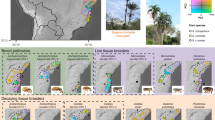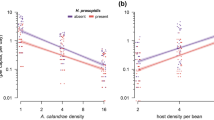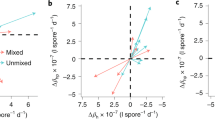Abstract
MODELS of evolution in parasite–host or predator–prey systems assume that particular pairs of species either always interact or never interact1. But, in nature, a particular parasite species may interact with a particular host species at some times (or in some places) but not at others, even if host availability is not variable. These differences could stem either from variation among con-specific hosts in their resistance to parasitism or from variation among conspecific parasites in their tendency to attack particular host species. We report here that both of these effects exist, that they are probably due to genetic variation both in parasites and in hosts, and that they interact to produce spatial variation in ecological relationships. We studied three potentially interacting species, a herbivorous insect and two of its potential host plants, at each of two sites. At one site, a plant species was avoided by the insects because of a combination of local insect preference and local plant resistance. This result shows that the diet is a property neither of the parasite nor of the host, but of the parasite–host interaction.
This is a preview of subscription content, access via your institution
Access options
Subscribe to this journal
Receive 51 print issues and online access
$199.00 per year
only $3.90 per issue
Buy this article
- Purchase on SpringerLink
- Instant access to full article PDF
Prices may be subject to local taxes which are calculated during checkout
Similar content being viewed by others
References
Futuyma, D. J. Evolutionary Biology 492–497 (Sinauer, Sunderland, MA, 1986).
Singer, M. C. Evolution 25, 383–389 (1971).
Fox, L. R. & Morrow, P. A. Science 221, 887–893 (1981).
Papaj, D. R., Rausher, M. D. in Herbivorous Insects: Host-seeking Behavior and Mechanisms (ed. Ahman, S) 77–124 (Academic, New York, 1983).
Rausher, M. D. Science 200, 1071–1073 (1978).
Tabashnik, B. Evolution 37, 150–162 (1983).
Prokopy, R. J., McDonald, P. T. & Wong, T. T. Y. Entomol. exp. Appl. 35, 65–69 (1984).
Singer, M. C., Ng, D. & Moore, R. A. J. Insect Behav. 4, 531–535 (1991).
Scriber, J. M., Giebink, B. L. & Snider, D. Oecologia 87, 360–368 (1991).
Maddox, G. D. & Root, R. B. Ecology, 71, 2115–2124 (1990).
Fritz, R. S. & Price, P. W. Ecology 69, 845–856 (1988).
Singer, M. C., Thomas, C. D., Billington, H. L. & Parmesan, C. Anim. Behav. 37, 751–759 (1989).
McDonald, B. A., McDermott, J. M., Allard, R. W. & Webster, R. K. Proc. natn. Acad. Sci. U.S.A. 86, 3924–3927 (1989).
Service, P. Oecologia 61, 271–276 (1984).
Ng, D. Nature 334, 611–612 (1988).
Alstad, D. N. & Edmunds, G. F. in Variable Plants and Herbivores in Natural and Managed Systems (eds Denno, R. F. & McClure, M. S.) 413–426 (Academic, New York, 1983).
Gould, F. in Variable Plants and Herbivores in Natural and Managed Systems (eds Denno, R. F. & McClure, M. S.) 599–654 (Academic, New York, 1983).
Thompson, J. N. A. Rev. ecol. Syst. 19, 65–87 (1988).
May, R. M. & Anderson, R. M. in Coevolution (eds Futuyma, D. J. & Slatkin, M.) 198–203 (Sinauer, Sunderland, MA, 1983).
Bernays, E. A. Evol. Ecol. 3, 299–311 (1989).
Author information
Authors and Affiliations
Rights and permissions
About this article
Cite this article
Singer, M., Parmesan, C. Sources of variations in patterns of plant–insect association. Nature 361, 251–253 (1993). https://doi.org/10.1038/361251a0
Received:
Accepted:
Published:
Issue Date:
DOI: https://doi.org/10.1038/361251a0
This article is cited by
-
Novel host plant use by a specialist insect depends on geographic variation in both the host and herbivore species
Oecologia (2024)
-
Host Plant Suitability in a Specialist Herbivore, Euphydryas anicia (Nymphalidae): Preference, Performance and Sequestration
Journal of Chemical Ecology (2018)
-
A test of concordance in community structure between leafhoppers and grasslands in the central Tien Shan Mountains
Arthropod-Plant Interactions (2017)
-
Endangered Quino checkerspot butterfly and climate change: Short-term success but long-term vulnerability?
Journal of Insect Conservation (2015)
-
Adaptive and maladaptive consequences of “matching habitat choice:” lessons from a rapidly-evolving butterfly metapopulation
Evolutionary Ecology (2015)



